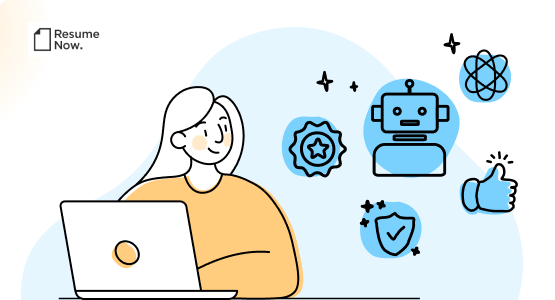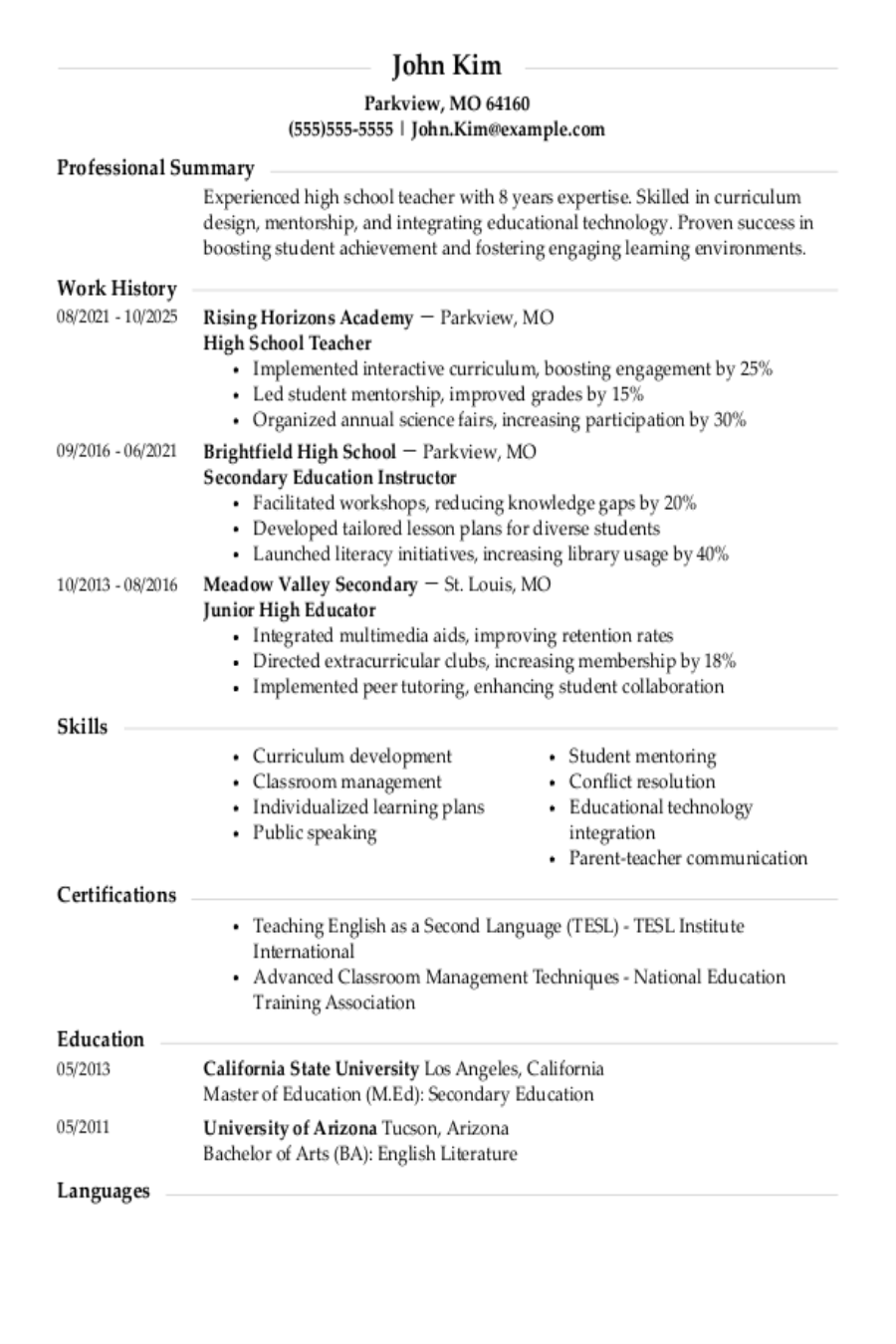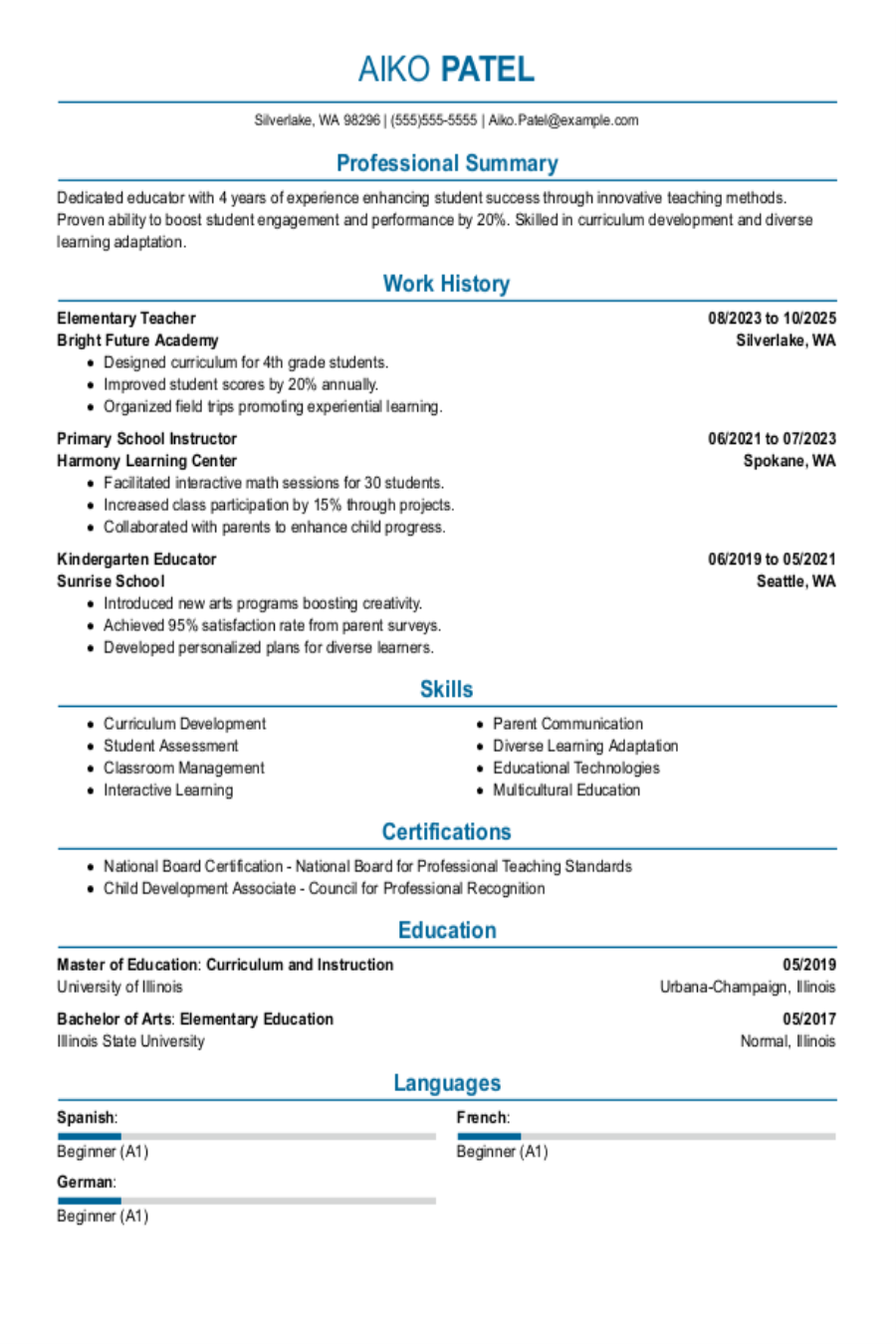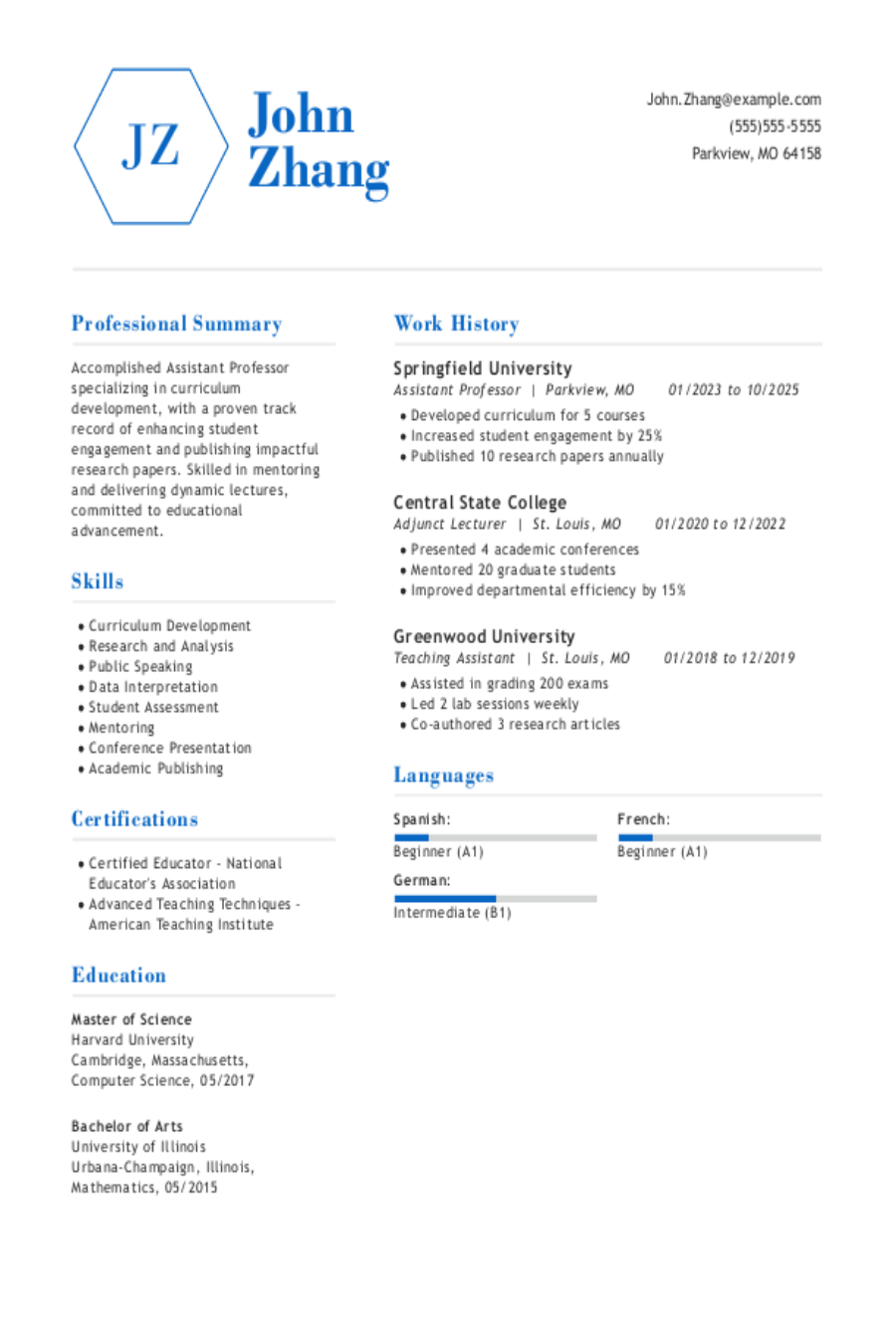The traditional resume format focuses on experience and credentials, emphasizing on-the-job achievements to allow you to showcase your skills. But what about early-career candidates? Recent graduates? Career changers? Enter the skills-based resume.
A skills-based resume, also known as a functional resume, is a resume that's—you guessed it—built around your key skills. Instead of focusing on listing career history, it builds out your qualifications using transferable skills, technical abilities, and interpersonal capabilities.
Learn how to write a skills-based resume that shows employers what you can do with the help of our guide.
Our guide will cover:
- What makes a skills-based resume different from a traditional one
- When and why you should focus your resume on skills
- How to create an impressive resume that emphasizes your relevant skills
- Sample resumes for different circumstances
Ready to build your resume and start your job search? Try our AI Resume Builder. Use this tool to help you build a resume in the format that works best for you, whether that's skills-based, traditional, or something in between. Our Resume Builder offers stylish, ready-to-use templates, unique content suggestions tailored to your career details, and step-by-step guidance for every resume section.
What Is a Skills-Based Resume?
A skills-based resume, also known as a functional resume, focuses on your professional skills. You might be thinking: "Aren't all resumes focused on career skills?" The answer is yes and no.
Every resume needs a robust list of professional and interpersonal skills to show employers what you bring to the table. In a traditional resume, you would list these skills and abilities in a skills section and integrate them within the job descriptions in your experience section. That last part is critical.
The most common type of resume, the chronological resume, is structured around describing your experience. In this format, your skills shine through your on-the-job achievements. This is perfect for candidates with plenty of experience, but not everyone has enough relevant job history to fill out this kind of resume.
For candidates without enough experience to use a chronological resume, a skills-based resume lets you flip the script. Instead of building your resume around experience, a skills-based resume is structured to showcase your specific skills that prove you can get the job done.
Instead of sticking to the usual parts of a resume, which include an experience section, a skills section, an education section, a header, and a resume profile, a skills-based resume offers more flexibility. While you'll still need to include specifics and examples of how you've used your skills to achieve results, you don't have to stick to the traditional resume outline to do so.
Instead of experience, a skills-based resume often features a summary of qualifications and a detailed professional skills section that takes a closer look at your skills by categories, showing how you've used your abilities to achieve results.
If you're considering a skills-based resume but have relevant experience you don't want to omit, the combination resume format might be the right strategic move for you. This format combines features of the skills-based and chronological resumes for a balanced approach to limited, but relevant experience.
Who Should Use a Skills-Based Resume?
To decide if a skills-based resume is right for you, take a close look at the strengths and weaknesses of your resume.
The most important things to keep in mind are these:
- Experience level: The most common reason to use a skills-based resume is a lack of experience. If you don't have on-the-job experience, then building a resume around a weakness won't support your strengths. Everyone starts with a first job, so land yours by creating a resume that showcases soft skills, education, extracurriculars, and other job-winning qualifications.
- Career changes: Not every career progresses in a straight line. If you're making a pivot in your career, then past experience may not be as relevant to your goals as the transferable skills you've earned. A skills-based resume can help you cut out the irrelevant industry jargon from your past roles and keep the spotlight on how they've prepared you for your future.
- Unique circumstances: From gaps in your employment history to freelance roles with lots of different clients, a skills-based resume can help you keep your strongest qualifications in focus, even when your experience doesn't neatly follow the typical layout of a resume.
How to Write a Skills-Based Resume
Writing a skills-based resume is no more difficult than any other resume, but the steps do look a little bit different. Let's go over them:
Step 1
Start with a resume header
Every resume starts with a header that includes your contact information so employers can reach you for an interview. Begin your resume with your first and last name, phone number, email address, city and state, and any professional links you wish to include, like a LinkedIn profile or portfolio.
It used to be common to include your home address on a resume, but these days it isn't necessary or appropriate. Protect yourself from job scams and save space for relevant information by sticking with your general location.
Step 2
Write a resume profile
A resume profile, in the form of either a professional summary or a resume objective, introduces the employer to your career in just a few sentences. Open with a short summary of who you are and your most relevant qualifications. If you're a beginner in your field, a resume objective that focuses more on career goals is a good strategy. Here's an example:
Recent graduate with a degree in early childhood development, passionate about supporting young learners through hands-on, child-centered education. Seeking a teacher's assistant role to apply knowledge of developmental milestones and Montessori principles to create a nurturing, engaging environment that fosters independence and curiosity.
Step 3
Build your skills sections
Next up are skills. For a skills-based resume, this often consists of multiple skills sections. A detailed summary of qualifications is a great way to dive into the specific technical abilities that fit your role or industry, while a more brief and general skills section allows you to list your transferable skills.
You can adapt your skills section to be whatever you want it to be, so don't be afraid to play to your strengths. Here's a sample of an impressive summary of qualifications:
Summary of Qualifications
- Strong academic foundation in early childhood development, with hands-on experience supporting the cognitive, social, and emotional growth of children ages 2–6
- Familiar with Montessori methods and principles, including child-led learning, independence-building activities, and sensory-based education
- Skilled in creating safe, inclusive learning environments that encourage exploration, kindness, and mutual respect
- Experience assisting in lesson planning, classroom organization, and activity facilitation during student teaching and volunteer roles
Not sure which skills to include on your resume? Our free AI Resume Skills Generator uses your career to generate a list of in-demand skills to add to your resume. Choose any skills that fit, use them as is, or add more details to make them shine.
Step 4
List your experience
A skills-based resume can, and often does, include an experience section. If you have any relevant experience, organize it into bullet points, look for measurable achievements to emphasize, and list it alongside your detailed skills sections. Here's an example:
Work History
Classroom Support Intern
Bright Futures Preschool – San Diego, CA
Jan 2025 – May 2025
- Assisted lead teacher with daily classroom routines, learning activities, and transitions
- Supported individual students during reading, play-based learning, and group time
Childcare Assistant (Part-Time)
Little Acorns Learning Center – San Diego, CA
Aug 2023 – Dec 2024
- Supervised 45 children ages 2–5 during free play, snack, and outdoor time
- Helped maintain a safe, clean, and engaging environment
Alternatively, many skills-based resumes opt out of the traditional work history section and replace it with a list of relevant skills.
A professional skills section should still discuss experience, but instead of focusing on specific roles, it highlights how your skills have helped you achieve results throughout your career journey, whether it's through a job, a volunteer role, an academic program, or an extracurricular activity.
Here's an example:
Professional Skills
Child Engagement & Activity Planning
• Designed and led weekly storytime and craft activities during volunteer shifts at a public library's preschool program
• Created engaging, age-appropriate games to support language and fine motor development
• Helped organize themed activity days for groups of up to 20 children ages 3–6
Communication & Parent Interaction
• Greeted families and helped facilitate smooth check-ins at a community children's center
• Provided verbal progress updates to parents after group sessions
• Collaborated with a multidisciplinary team of volunteers to coordinate special events
Organizational Skills & Reliability
• Maintained consistent attendance and completed a 100-hour volunteer commitment during one academic semester
• Followed daily activity plans and ensured timely setup and cleanup of shared learning spaces
• Assisted with preparing materials and managing transitions between program sessions, contributing to a 15% improvement in on-time session starts
Step 5
List your education
Include an education section toward the bottom of your resume that lists your degrees in reverse-chronological order. You can omit your high school diploma if you've earned a college degree. Here's an example:
Education
B.A. in Early Childhood Development
San Diego State University
Graduated 2024
Step 6
Include optional resume sections
Using a skills-based resume format is all about adapting your resume to fit your needs and putting your best foot forward. If you have unique qualifications to showcase, list them on your resume. Create a section for impressive achievements like certifications, volunteer work, languages, and personal projects.
Skills-Based Resume Examples for Different Circumstances
Now that we've covered what a skills-based resume is and how you can write an impressive one, let's look at some skill-based sample resumes for different career situations. If you need more inspiration for your resume, look for resume examples from professionals in your industry in our sample resume.
General skills-based resume
Skills-based resume for a recent graduate
Skills-based resume for a career change
Skills-based resume for an industry transition
Final Thoughts
A resume's purpose is to communicate with employers and give them confidence in your abilities. If following the rules for writing a resume is hindering your job search, then throw them out! The best thing you can do with your resume is highlight your strengths. That's why the skills-based format works so well for early-career candidates.
If you're worried about your skills-based resume's ability to pass through applicant tracking systems (ATS), our free ATS Resume Checker can give you peace of mind and offer pointers to help improve your resume's performance.
And, if you're concerned about making your functional resume look polished and professional, a ready-to-use resume template can help you feel confident as you apply. Resume Now's library of resume templates is adaptable and will work just as well with a skills-based format.
Key Takeaways
Use skills to highlight strengths.
The skills-based resume format is ideal for early-career candidates, professionals with nontraditional career paths, or anyone changing careers. Use this format to highlight your resume's strongest points instead of dwelling on experience that may be irrelevant or lacking.
Center your resume on skills.
A skills-based resume takes the chronological format's emphasis on work history and shifts it to skills. You'll still need to build the traditional sections of a resume, but instead of a lengthy experience section as your resume's backbone, build the core of your resume around various detailed skills sections.
Adapt your resume to your needs.
While researching the process of building a resume, you'll come across a lot of rules, tips, and ideas. It's important to keep in mind that the "rules" exist to help you succeed. If they're not doing so, then you can bend and adapt them until they do. A skills-based resume helps you do that by adapting the typical resume style to fit your unique career.
Resources to Help With Your Job Search
- How to Use AI for Your Job Search in 2025
- 12 of the Best No-Degree Jobs for Parents
- How to Get a Job With No Experience or References
- First Job Resume: Guide & Examples
- 18 Resume Tips to Help You Write the Best Resume
- How to Quit a Job You Just Started
- 11 High-Paying Jobs That Are Less Stressful AND Flexible
- 20 Surprising High-Paying Jobs You Can Do from Home
Was this information helpful? Let us know!
Hailey is a career advice writer dedicated to helping job seekers excel in their careers.
More resources

RoboBossing: 66% of Workers Say AI in Leadership Would Make the Workplace More Fair and Efficient
Resume Now s latest report finds growing support for thoughtfu...

How to Write a Resume for a Career Change
Need a resume to showcase your unique career path? Our guide c...

Ultimate Guide to Free Google Docs Cover Letter Templates
Look at these five best google docs cover letter templates whi...

High School Teacher Resume for 2025: Examples and Guide
Get inspired with our high school teacher professional resume ...

Elementary Teacher Resume: Examples, Templates & Tips for 2025
Was this information helpful? Let us know &star &star &star &s...

Assistant Professor Resume: Examples, Templates & Tips for 2025
Looking for a job as an assistant professor? Check out our tai...
